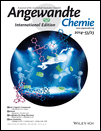On-Top π-Stacking of Quasiplanar Molecules in Hole-Transporting Materials: Inducing Anisotropic Carrier Mobility in Amorphous Films†
This work was partially supported by JST and the Collaborative Research Program at the ICR, Kyoto Univ. Support was also received from the Funding Program for World Leading Innovative R&D on Science and Technology (FIRST Program). The NMR measurements were supported by the Joint Usage/Research Center (JURC) at the ICR, Kyoto Univ. Synchrotron single-crystal X-ray analysis was carried out with the SPring-8 beam line BL38B1 with the approval of JASRI (2012A1448, 2012B1319, and 2013A1489). 2D GIXD experiments were performed at BL19B2 of SPring-8 with the approval of JASRI (2013A1634). We thank Dr. T. Koganezawa (JASRI) for advice on the 2D GIXD measurements.
Graphical Abstract
Taking charge: Dimers of partially oxygen-bridged triarylamines that form on-top π-stacking aggregates in the crystalline state were shown to induce high levels of anisotropic charge transport in the direction of the π-stacking. Surprisingly, these compounds retained some of the face-on π-stacking even in vacuum-deposited amorphous films, thus facilitating an out-of-plane carrier mobility.
Abstract
Dimers of partially oxygen-bridged triarylamines were designed and synthesized as hole-transporting materials. X-ray structural analyses revealed that these compounds form on-top π-stacking aggregates in the crystalline state. TRMC measurements showed that high levels of anisotropic charge transport were induced in the direction of the π-stacking. Surprisingly, even in vacuum-deposited amorphous films, these compounds retained some of the face-on π-stacking, thus facilitating an out-of-plane carrier mobility.





